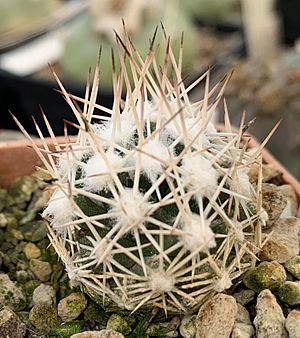Escobaria robbinsiorum facts for kids
Quick facts for kids Escobaria robbinsiorum |
|
|---|---|
 |
|
| Conservation status | |
| Scientific classification | |
| Kingdom: | |
| (unranked): | |
| (unranked): | |
| (unranked): | |
| Order: | |
| Family: | |
| Subfamily: | |
| Tribe: |
Cacteae
|
| Genus: |
Escobaria
|
| Species: |
E. robbinsorum
|
| Binomial name | |
| Escobaria robbinsorum (W.H.Earle) D.R.Hunt
|
|
| Synonyms | |
|
Coryphantha robbinsorum |
|
The Escobaria robbinsorum is a very rare type of cactus. It is also known by its common names, the Cochise pincushion cactus and the Cochise foxtail cactus. This special plant lives in southern Arizona in the United States and northern Sonora in Mexico. It is so rare that it was listed as a threatened species in 1986. This means it needs protection to survive.
Contents
About the Cochise Pincushion Cactus
This cactus is unique because it mostly grows hidden underground. Only a few centimeters of its top are visible above the ground.
What Does It Look Like?
Each part of the cactus has a cluster of spines. These spines are surrounded by soft, white, woolly hairs. The spines are straight and white, sometimes with dark tips. They are about 1 to 2 centimeters long.
The flowers of this cactus are 1 to 3 centimeters long. They have greenish-yellow petals, which are called tepals. After the flower, a bright red or orange fruit grows. This fruit is juicy and less than a centimeter long.
Where Does It Live?
The Cochise pincushion cactus grows in places with very little soil or sand. It prefers almost solid rock and needs full sunlight. You can find it growing in large groups, sometimes with up to 1000 individual plants!
Why Is It in Danger?
This rare cactus faces several challenges that make it hard for it to survive.
- Dry Weather: Long periods of drought (very dry weather) in the region have caused many cacti to die. When it's dry, the cacti can shrink and pull back into the ground. This makes them even harder to find.
- Human Activities: Activities near the Mexico–United States Border can sometimes affect the plants. Also, some people might try to collect these cacti because they are rare. However, the groups of plants in Arizona are usually well-protected from this.
- Land Use: Searching for oil and grazing animals can also impact the areas where the cactus grows.
- Other Plants: Invasive plants, like buffelgrass, are growing more common in the desert. These plants compete with the native cacti for space and resources.
- Insects: Insects seem to harm the cacti, but scientists are still studying how much damage they cause.
- Slow Growth: This cactus does not reproduce very quickly. Each plant makes only about 20 seeds per year. New plants grow very slowly.
Scientists are still learning about the Cochise pincushion cactus. They need to study more about what it needs to grow, how it interacts with animals that eat it or help it, and how many plants there are.


